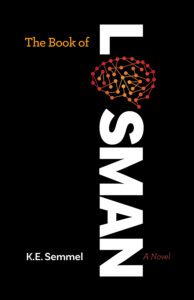
The Author: K.E. Semmel
The Book: The Book of Losman (Santa Fe Writers Project, 2024)
The Elevator Pitch: A literary translator with Tourette becomes involved in an experimental drug study in a tragicomic effort to find a cure for his condition.
***

The Rumpus: Where did the idea of your book come from?
K.E. Semmel: The central idea behind The Book of Losman came to me years ago, when I was writing another novel, a retelling of Beowulf set in the Southern Tier of Western New York state.
I’m the type of writer who sits on an idea for many, many years, rolling it around my head until it collects mass. If the idea is a good one, it gets bigger and develops into something. If it’s not a good one, I let it go, or it just fades from consciousness.
The seed behind The Book of Losman was a pill that could allow users to relive their long- forgotten childhood memories. I’ve always been fascinated by memory, particularly the gaps we all have. Years ago, I’d read Pagan Kennedy’s excellent novel Confessions of a Memory Eater. In that novel, a pill called MEM allows the protagonist, a man named Win Duncan, to relive his best memories. In other words, things he already remembered. In The Book of Losman, the memories recalled with the pill, BHME4, are ones Losman cannot recall without the aid of the pill: childhood and babyhood memories.
The problem, in the beginning, was that I didn’t have a structure around which to develop the idea. What was the purpose of recalling long-lost memories? It wasn’t until I was officially diagnosed with Tourette Syndrome around six or seven years ago—I’ve been ticcing nearly all my life—that I found a structure. Why I tic is one of the great mysteries of my life. So I thought, I will explore these tics using Losman and his memories. And I will have some fun doing it. I wasn’t looking for answers, I was looking to tell a good story.
Rumpus: How long did it take to write the book?
Semmel: I wrote the first draft in about two years, and it took another three years to revise it into shape. And, of course, it has now been in the publishing pipeline for about two years, with more changes. So, all in all, it’s been around seven years.
Rumpus: Is this the first book you’ve written? If not, what made it the first to be published?
Semmel: Over the past thirty years I’ve written seven unpublished manuscripts and countless unpublished short stories. Some of my earliest work is simply apprentice work and frankly not very good. I’d say it was only within the last ten years that I finally found a storytelling voice and became a decent enough writer to be recognized by agents, editors, and publishers as someone to pay attention to. Even still, it’s difficult to get work noticed.
My retelling of Beowulf took ten years and seventeen drafts to be completed. It was a multiple POV novel and I had to do a lot of research. In the end, it was rejected by more than fifty agents before I finally landed one. Then, after all that, my agent shopped it around to countless publishers and it was rejected by them all. When I finally threw in the towel with that book, I told myself I would use the maxim “write what you know” with the next one so that I wouldn’t have to spend another decade writing a book that wouldn’t get published.
That’s why The Book of Losman involves a literary translator in Denmark with Tourette Syndrome. Losman came to me rather quickly because I knew who he was much earlier in the writing process, and I didn’t get bogged down in too much research.
Rumpus: In submitting the book, how many no’s did you get before your yes?
Semmel: My agent shopped The Book of Losman to around three- to four-dozen publishers, all with the same sad conclusion: no. I don’t recall the exact number. Once again, I got a number of great, even encouraging rejections, but no one was willing to roll the dice on the novel.
It was a very dispiriting process. So, to take my mind off it, I wrote an MG novel that’s kind of like The Wizard of Oz meets The Phantom Tollbooth, and I parted ways (amicably) with my agent. He didn’t really agent MG novels, so I figured it was a chance to start afresh. I assumed I could get another agent, but I was wrong about that. I still don’t have an agent, and I’ve more or less given up on this MG novel.
Because I still believed in Losman, though, I entered the novel in the Santa Fe Writers Project’s Literary Awards Program. It didn’t win, but the publisher, Andrew Gifford, wanted to publish it all the same. The Book of Losman is a great fit for SFWP. They also published my translation of Simon Fruelund’s collection MILK, and I’m very deliberately playing on Simon’s work in the novel—something that surely helped my pitch to SFWP. The entire opening scene is a reimagining of Simon’s short story “Kramer,” published in Milk. Losman is a kind of companion book to Milk, or at least certain stories in that collection.
Rumpus: Which authors/writers buoyed you along the way? How?
Semmel: For starters, Simon Fruelund and all the writers I’ve translated. I’ve written about why I believe being a translator helps make writers better at writing fiction for The Millions. I wouldn’t be the writer I am today without my translation work. There are quite a few contemporary Danish writers I love, whether I translated them or not: Jacob Ejersbo, Helle Helle, Naja Marie Aidt, Kenneth B. Andersen, and Simon of course.
I read widely, though, usually around a hundred or so books a year. Benjamin Percy and Stephen King satisfy my craving for horror and/or thrillers. Joyce Carol Oates, a fellow native Western New Yorker, has been a huge influence on me, her storytelling propulsion in particular. Writers whose work was very important to me while I was drafting Losman: A.M. Homes, Jennifer Egan, Colson Whitehead, Lev Grossman, Matt Haig, Ransom Riggs, Emma Straub, Edan Lepucki, and Rion Amilcar Scott.
Rumpus: How did your book change over the course of working on it?
Semmel: When I began writing the book, I knew Losman would be a literary translator in Copenhagen. As I went along, that part of the story became more and more important. It’s not heavy-handed—I didn’t want to tell a “writer” story, and I don’t—but over time, translation became much more of a core element. As an example, I didn’t start out writing a book that would become thematically entwined with Simon Fruelund’s fiction, especially his short novel The World and Varvara and his collection Milk. But that’s what happened.
Rumpus: Before your first book, where has your work been published?
Semmel: I’ve translated around a dozen books for various publishers, both indie and Big Five, along with a slew of short Danish fiction for literary journals. My fiction has appeared in Gargoyle, Aethlon, Monkeybicycle, and Ontario Review. Joyce Carol Oates personally accepted my first published short story, in fact, way back in 2005. At that point, I thought I was well on my way to publishing more of my fiction. Little did I know that I would have a long way to go.
My nonfiction has appeared in Lithub, The Writer’s Chronicle, World Literature Today, Necessary Fiction, The Southern Review, The Millions, HuffPost, The Washington Post, and elsewhere.
Rumpus: What is the best advice someone gave you about publishing?
Semmel: Don’t take rejection personally.
Rumpus: Who’s the reader you’re writing to—or tell us about your target audience and how you cultivated or found it?
Semmel: The target reader for The Book of Losman is someone who enjoys novels like Matt Haig’s The Midnight Library and Emma Straub’s This Time Tomorrow. These books bend reality by utilizing elements of magic realism to explore broader issues such as “Who am I? How did I become who I became? What if I had done things differently?” My typical reader also enjoys watching films and TV shows like Black Mirror, Love Death + Robots, Being John Malkovich, and Locke & Key. What’s important is that they be open to a twisted version of reality, to a new way of seeing the world. This audience has a good sense of humor and appreciates it in the novels they read.
Rumpus: What is one completely unexpected thing that surprised you about the process of getting your book published?
Semmel: It can take up to two years to go from acceptance to publication when you publish with a traditional publisher. That’s a lot of time for something to go wrong. But this process has been very smooth for me, even though I figured there’d be some hiccups along the way. Andrew Gifford, SFWP’s publisher, provides his writers with a document that outlines the publishing process from A to Z. This document gives his writers an idea of what to expect at every step, which in turn also allows them to plan their marketing and communications activities. I don’t know if other presses provide such a document, but it has proven to be hugely important for me.
One thing this document helped me realize, for example, is that I didn’t have to suddenly become an influencer on social media, which was never going to happen and caused me a great deal of anxiety at first. Instead, I could use my writing skills to pen articles and other pieces that could help the book succeed. And that’s what I’ve been trying to do.
***
Author photograph by Gerry Szymanski




